京都工芸繊維大学KYOTO Design Labでは、KYOTO Design Lab10周年を記念し、5つの連続シンポジウムを開催しています。「Designing Possible Future」をスローガンに、次世代の都市・デザイン・建築の学問的拠点として、そのありうべき未来について議論を深めていきます。
2023年8月25日〜8月27日にわたり、その第一回目となる「システム移行を前提とした循環デザイン」を3日間にわたり、開催しました(共催:Circular Design Praxis、株式会社Re:Public)。議論のエッセンスをお届けします。
DAY 0/2023.8.25
この日、シンポジウムに先立ち、金沢大学、慶應大学、京都工芸繊維大学から学生及び教員が集結。翌日から始まるシンポジウムの「導入」ともいえるテーマ別のディスカッションと発表がおこなわれた。
学生は3グループに分かれ、「廃棄物から資源への転換:ゴミはいつからゴミになるのか?」「見過ごされてたものの再生産」「持続可能社会の“合意形成”においてルールはどうあるべきか?」というテーマを設定。それぞれの発表では、サーキュラーを「環」として捉え、廃棄物から資源の転換を促す物語性のあるキーワードの重要さ、デザイン行為を通じた環境の認識の更新や新陳代謝の必要性、持続可能な社会の基礎になるべきボトムアップの世界観が提示され、さらに研究者を交えたかたちで問題を掘り下げる議論がおこなわれた。
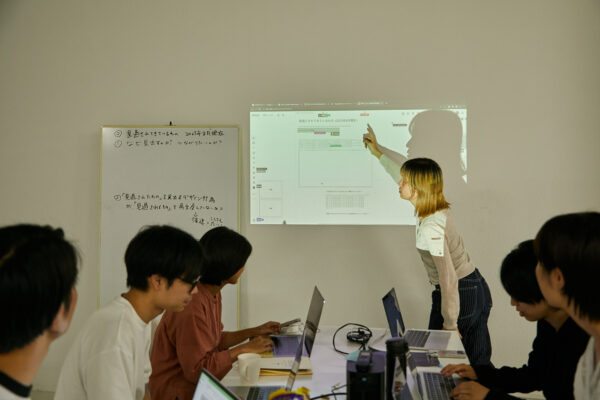
学生グループは、金沢大学、京都工芸繊維大学、慶応大学の3大学混合で結成し、それぞれの研究分野から与えられたテーマについて議論がおこなわれた。
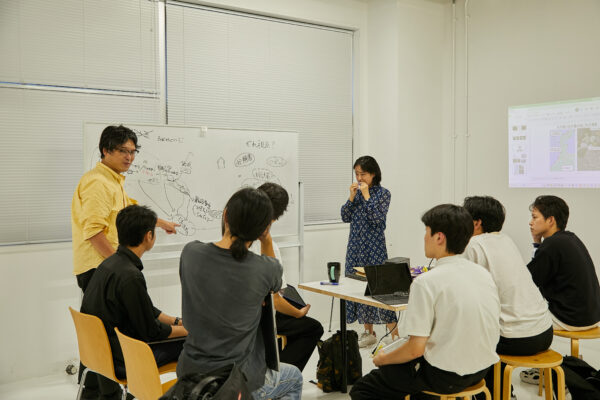
各グループには、シンポジウムの登壇者も参加し、大学や研究領域の枠を超えたディスカッションが白熱してゆく。
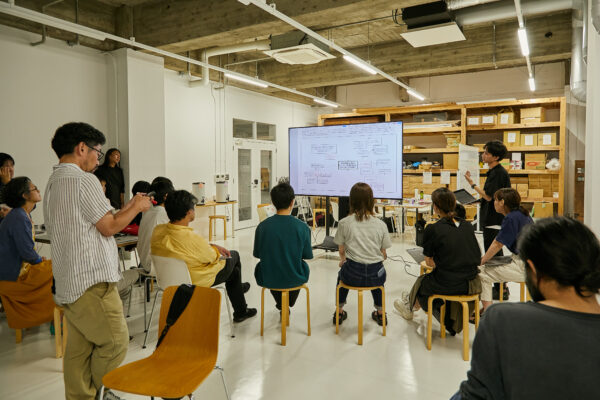
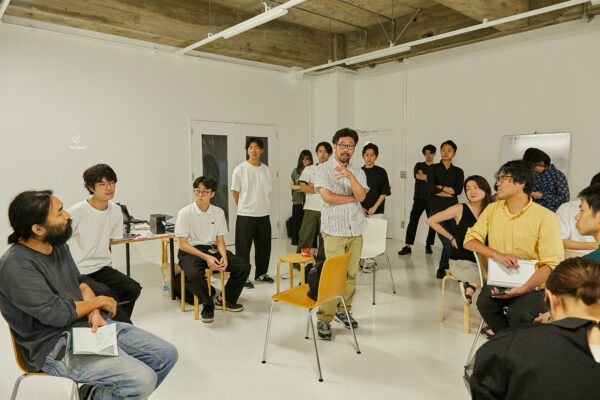
各グループでの議論の内容を「しんぶん」形式のメディアフォーマットにまとめ、順に発表。教員や登壇者のフィードバックではさらなる議論が展開された。
DAY 1/2023.8.26
いよいよ本格的なシンポジウムが開始されたこの日は、「自律分散的な資源循環」「ビジネスとインダストリアル・エコロジー」「土着のふるまい」という3つのテーマでセッションが実施された。
Session A「自律分散的な資源循環」では、日本におけるリサイクルの変遷にはじまり、循環システムの実相についてマクロとミクロの両面から多様な切り口で語られた。つづくSession B「ビジネスとインダストリアル・エコロジー」では、“バブル状態”にあるライフサイクルアセスメント(LCA)の現在と今後のあり方をはじめ、消費者・企業の認知をいかに拡張させていくのかについて意見が交わされた。最後のSession C「土着のふるまい」では、循環型社会が内包する根本的な「暴力性」の問題を軸にして、地域主義的な産業への転換や、脱暴力のためのデザインの有効性が議論された。
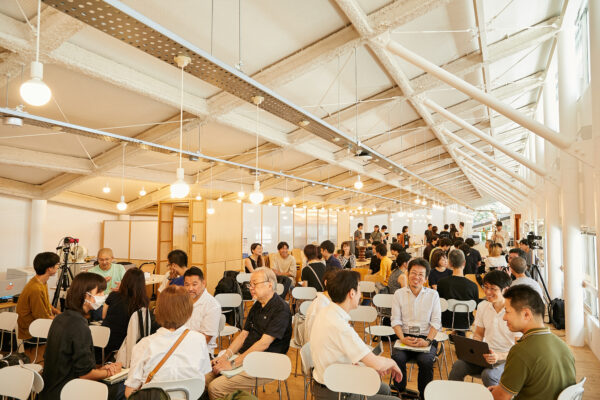
研究者に限らず、あらゆる企業や自治体からのべ135名が集結(オンラインではのべ123名が視聴)。イベント冒頭では互いに関心のある領域について意見交換を行うアイスブレイクの時間が設けられた。
Session A 自律分散的な資源循環
登壇者:
田中浩也 [慶應義塾大学 教授]
田崎智宏 [国立環境研究所 資源循環社会システム研究室]
ファシリテーター:
津田和俊 [京都工芸繊維大学 准教授]
市川文子[株式会社Re:Public]
「消費者」から「循環者」へと変わるために
資源循環の社会的価値を「物語」として伝えていく
ギガトンの氾濫とも呼ばれる大量生産・大量消費・大量廃棄型の社会をいかに脱却し、適量生産・自律分散・資源循環型の社会に移行するか──この課題について、国際社会や国のマクロな環境政策を調査・分析・評価してきた田崎氏と、鎌倉市をフィールドにデジタルファブリケーションを活用するなどした実践的かつ多義的な資源循環を研究する田中氏がセッション。議論では、リサイクルの実態や本質を把握することの必要性や、市民が「消費者」ではなく「循環者」であると自覚すること、そうした意識・行動変容の促進に資源循環の社会的価値を「物語」として伝えていくことの重要性が指摘された。
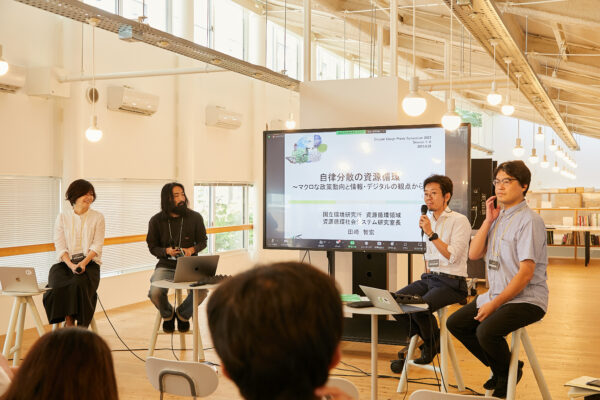
左から市川氏、津田准教授、田崎室長、田中教授
「フローの循環」から「ストックの循環」に
移行するための戦略を
資源循環を考えるなかで飛び出したトピックのひとつが、「循環する量には上限がある」という問題。リサイクル率の向上が目標化されるなどの取り組みは進むが、人口減少が進行する社会において、現在のストックを30年後にリサイクルして使い切るだけの需要が果たしてあるのか。このセッションでは、「フローの循環」から「ストックの循環」に移行するために必要な戦略、視点についても検討がなされた。
田中(画像右端):リサイクル率とかリサイクルという言葉だけで物事を見てしまうのはたぶん間違っていて、具体的に「これはどこに行くのか、そのニーズはどれぐらいあるのか」というところから逆算しないといけない。本当は、リサイクルってあんまり褒められたことではないということだと思うんです。
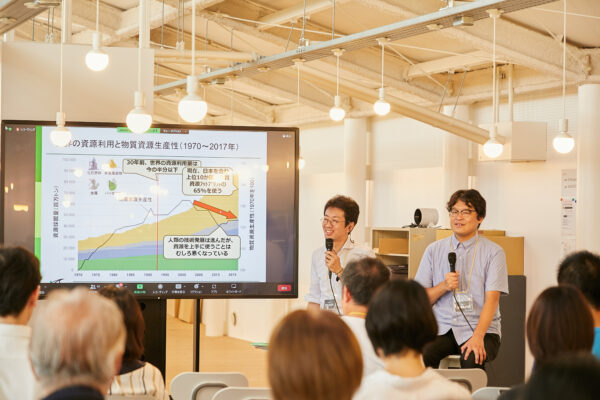
田崎:循環する量というのは、やはりある時点で上限があるので、そこを抑えていく必要がある。そのためには長期的に使っていく必要がある。つまり長く使うことを前提とした設計をしていかなくてはならないということだと思います。
田中:僕が携わっている自治体もまだ志半ばで、「大量生産、大量消費」が前提になった「大量リサイクル」の段階。「大量」であることが温存されてしまっているんです。量として減らしていくための戦略、フローの循環からストックの循環に移行するための戦略のようなものが必要だと思うんですね。
ただ、たとえば、フローの循環で使っている材料と、ストックの循環で使っている材料が違うといった問題もあります。そこをどう接続できるかというのは、まだ悩んでいるところで。
田崎:最初から木でつくってバイオマスで循環させるとか……。
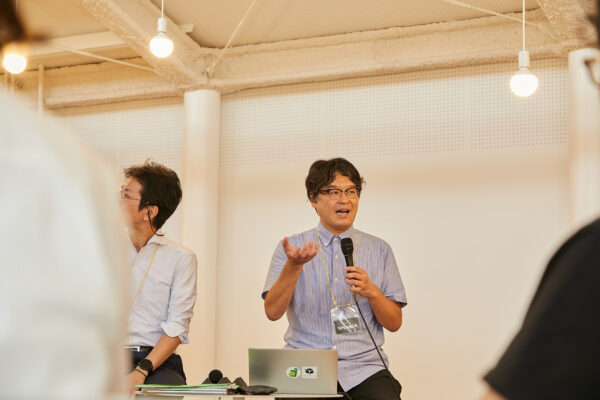
田中:プラスチックを活用できるように耐候性を高める研究をしているんですが、結構無理やりなんです。「プラスチックで建築物をつくる」というのが、良いのか悪いのか……。そんななかでひとつ、アイデアとしてあるのは、「浮かぶもの」なんです。地球温暖化の影響による洪水などの自然災害が今後増えていくと想定して、ボートのような、なるべく浮かぶものをつくる。あくまで私が個人的に持っている構想なんですけれども。
Session B ビジネスとインダストリアル・エコロジー
登壇者:
奥林里子 [京都工芸繊維大学 教授]
天沢逸里 [東京大学 特任准教授]
河内幾帆 [金沢大学 准教授]
ファシリテーター:
水野大二郎 [京都工芸繊維大学 教授]
田村 大[株式会社Re:Public]
持続可能な経済・技術的システム構築を
発展させるために必要な論点を整理
持続可能な社会に向けて、自然の生態系に着目した産業の循環システムが提唱されたのは1990年代のこと。しかし、そこから20年以上経た現在も、依然として生産時のゼロウェイスト化や廃棄物の再利用、インバース・マニュファクチュアリング、シェアやレンタルなどの余剰資源の有効活用など、持続可能な経済・技術的システム構築は発展途上の状況にある。このセッションでは、バックグラウンドが異なる3人の研究者が、サーキュラーエコノミーへの転換に必要となる諸課題について議論。LCAをめぐる現況や、消費者が抱える「学習性無力感」の問題、企業活動を評価する際の視点を変化させることの必要性など、多岐にわたる論点が挙げられた。
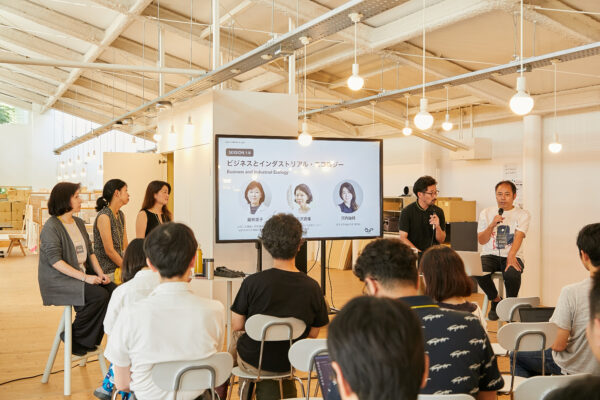
右から田村氏、水野教授、河内准教授、天沢特任准教授、奥林教授
「プロスペクティブLCA」は
行動変容に影響を与えられるのか
近年、ニーズが高まっている「プロスペクティブLCA」。すでに普及している製品やサービスの製造・提供から廃棄までにかかる環境負荷を評価する従来のLCAとは異なり、開発段階の不確実な新技術やサービスの環境負荷を評価するものだ。プロスペクティブLCAは行動変容のための新たな鍵となるのか。活発な意見交換がおこなわれた。
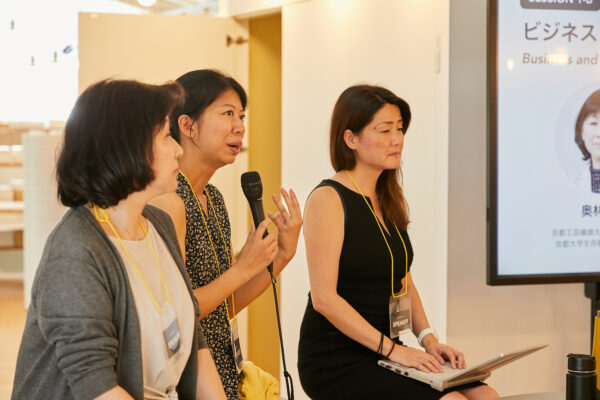
天沢:私がいま所属しているセンターでも「未来戦略LCA連携研究機構」を新たに設立しました。事前に環境影響を把握することができれば、その情報を戦略的に製品開発やビジネスなりに生かせるということで、企業の方々にも入っていただいて、将来のLCAをどうしていけばいいのかをまとめようとしています。
水野:非常に面白いなと思います。でも、どれくらい「絵に描いた餅」みたいなものをやらないといけないのかという話にもなりそうですね。下手をしたら、新しい産業生態系、新しい生活者像みたいなことも含めて、新しい未来を全部つくらないと描けないよね、というような。
天沢:そこまで描くのはとても難しいので、いまの世界が続くことを前提としたようなかたちでやっています。あと、いまは行動変容の点まで含めて考えられていないので、それは入れたほうがいいという意見を持っています。
水野:さきほど河内先生が「社会システムの前提となっている人々の意識/無意識的な思い込みや価値観を変えることが、環境問題に対する行動変容に影響を与えるのではないか」といったお話をされていましたが、プロスペクティブLCAと消費者の行動変容について、どう考えますか?
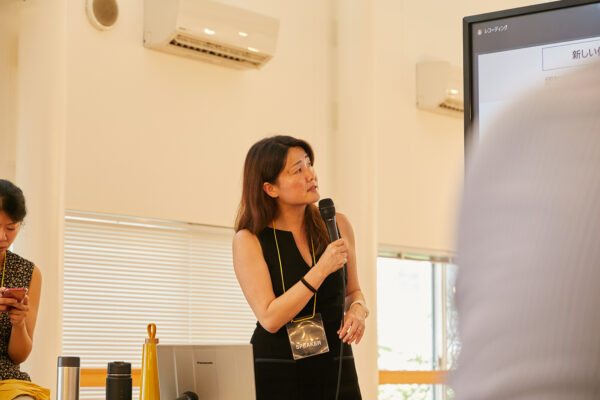
河内:とても重要だと思います。消費者は認知や理解の範囲を超えてしまうと結局何がいいのかわからない状況になってしまう。なので、消費者が理解できる範囲での鍵となるパラメーターとして、「これが変わるとこうなりますよ」というのがなるべくシンプルに単純化された状態で伝わると、消費者がそれをベースにした行動変容ができるのではないかと思いました。
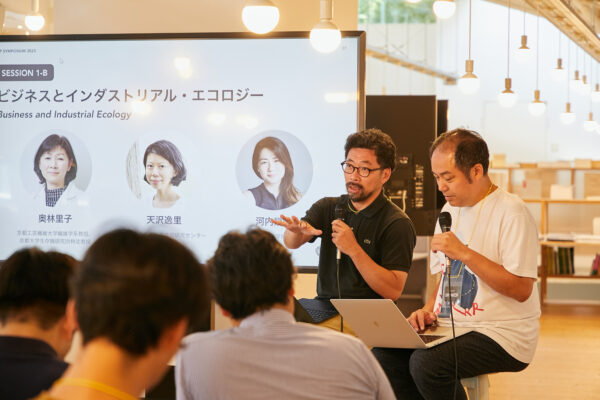
水野:地球に対する自己効力感みたいなこととして認識したいですよね。この問題について、動脈側にいると思われる奥林先生はどんなふうに思いますか? 奥林先生が研究されている、水を使用せず二酸化炭素で染める「超臨界染色」は産業側の製造時の水資源利用の問題ですし、動脈側のロジックというのが生活者にはまるようなことを十分に考えきれていない部分があるのではないかなと思うんですけれども。
奥林:じつは超臨界染色は、LCAで言うと良いのかどうかがまだわかっていないような状態なんですが、まさにプロスペクティブLCAのような事前評価が必要だろうと、学内でプロジェクトが立ち上がっているところです。また、超臨界染色はタイやベトナム、台湾ではおこなわれているのですが、日本では法規制などがあり、まだやっていないものです。なので、いまはこの技術が購買理由になることは、なかなかないだろうというのが現状ですね。
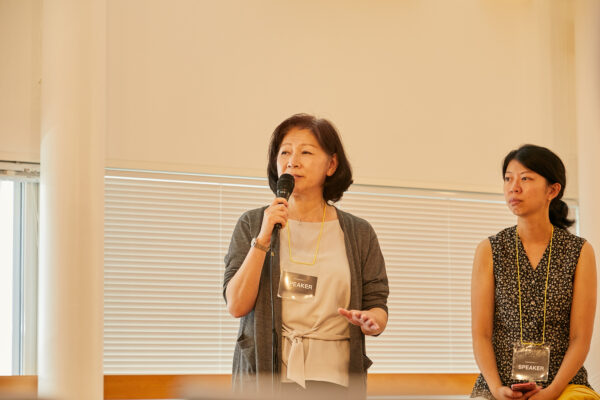
Session C 土着のふるまい
登壇者:
中村 寛 [多摩美術大学 教授]
岩瀬大地 [東京造形大学 准教授]
ファシリテーター:
水内智英 [京都工芸繊維大学 准教授]
神尾涼太 [株式会社Re:Public]
帝国型生活様式から脱するヒントとしての
「地域主義的生産」と「脱暴力」を考える
環境収容力の限度・限界のなかでいかに資源を循環させ、豊かに暮らせる社会をデザインできるか。そのヒントになるのが、地域の資源や伝統知識、技術を生かした「地域主義的生産」。前近代から継承されてきた各地域に根ざした知恵は、近代が見過ごしてきた多元的な視座を有しているからだ。このセッションでは「帝国型生活様式」から脱し、長期的に変容していくためのモデルとしてグローバルサウスにおける地域主義的生産の実例を共有。また、サーキュラーデザインを考える上で資源の収奪をはじめとした「暴力」とどれだけ向き合っていくことができるかという、「脱暴力」のためのプロセスの重要性についても再確認された。

循環型社会がはらむ「暴力性」を認識し、
より暴力が縮減されていくシステムをデザインする
日本や欧米の経済成長は途上国の資源の搾取という暴力によって成り立ってきたが、資源の大量循環もまた、こうした搾取を増加させてしまう。循環型社会の「暴力性」という問題に対して、どうアプローチし、脱暴力のためのデザインを提供できるか。この議論では、サーキュラーデザインに向かうためのアティチュードともいうべき重要なテーマが語られた。

中村:20世紀というのは、問題解決と言いながら暴力を増大・加速化させているデザインが多く散見されていました。そして21世紀には暴力の効率はさらに良くなっていった。科学の知と経済資本主義、そしてデザインの創造力が組み合わさることによって組織化・制度化した暴力が、いつの間にか我々の生活に溶け込み、見過ごされてきたのです。直接的で残虐と見なされる暴力だけではなく、こうした構造的・集合的な暴力にも目を向け、どのように解消していくのかを考えるのが、デザインの力かなと思います。

岩瀬:資本主義社会というのは環境問題をひとつとっても基本的に暴力的で、構造的な暴力がある。我々にはそういう暴力的な部分が見せられてないというか、隠されていますよね。あらためて中村先生のお話を伺って、サーキュラーデザインや循環型社会というものは、そうした暴力性をはらんだものなんだという認識を持つことがとても必要だと思いました。完全な循環型社会をつくったとしても、結局、自然の収奪であるとか廃棄物を生んでしまうことは避けられない、暴力性は付きまとうんだと認識した上で、循環型社会の設計を考えていかないといけない。
中村:そうですね。完全に非暴力的な世界を構築するということはできないので、予防的、改良的、あるいは修復的、治癒的なアプローチというのが非常に重要です。そして、より暴力が縮減されていく設計、あるいは突発的な大きな暴力が起きにくいシステムをデザインは提供できるのだろうと思うし、そこに踏み込んでいける段階にあるんじゃないかとも思っているんですね。
たとえば、資本主義のなかでつくられてきた我々の欲望みたいな設計にも結構な時間がかかってきた。だけど、あっという間に世界中を覆い尽くしていくような力をデザインが発揮したのだとすると、それを逆のベクトルに向けていくことが今後の課題になっていくし、むしろチャレンジしてみたいなと私は思うんですね。マインドセットをいじるのはすごく時間がかかるし、カルチャーを設計するとなると少なくとも3世代ぐらいはかかるでしょう。しかし、気候変動などの「待っていられない問題」にかんしては、対処療法として、介入することの暴力を認めつつも設計していくことが必要になっているのだろうと考えているところです。
DAY 2/2023.8.27
シンポジウム最終日のこの日は、まず最初に前日のセッションを振り返って整理。赤間氏のアイデアにより、「世界観を身体で受け止める」手がかりとして参加者みんなで太極拳を体験するなど、ユニークなスタートとなった。
皮切りのSession A「土地に根ざすサーキュラーデザイン」では、異なる地域・異なる立場でサーキュラーデザインを実践する3名が研究結果や成果に基づいた今後のあり方を意見交換。つづくSession BとSession Cは同時開催され、Session B「サーキュラーデザインの人材育成」では課題解決型思考からの脱却と探索的なアプローチの有効性がキーワードに。Session C「サーキュラーデザインの制度設計」では法律・制度整備の観点から産業・自治体などが抱える現状の課題が浮かび上がった。
そして、シンポジウムの締めくくりとしておこなわれたのが、赤間氏による基調講演。講演では、周縁化・不可視化が組み込まれた循環の抽象概念を捉え直すためのさまざまな考え方が提案された。
3 日間にわたり多様なテーマと多彩なゲストスピーカーによって実施されたセッションと講演。それぞれのテーマや問題意識が有機的なつながりを生み、今後デザインがどのように進むべきであるのかを多角的に検討する時間となった。
Session A 土地に根ざすサーキュラーデザイン
登壇者:
西塔大海 [合作株式会社 取締役]
曽我修治 [日立製作所 研究開発グループ]
湯浅亮平 [慶應義塾大学 特任講師]
ファシリテーター:
増井尊久[株式会社Re:Public]
江戸時代の循環型社会を基点に、
地域のエコロジーを再構築するための課題、可能性を探る
土地に根ざした(=place-basedな)サーキュラーデザインを実践するためには、その土地のエコロジーを再構築する必要がある。このセッションでは、再構築にあたっての課題と可能性について、滋賀県長浜市に色濃く残る江戸時代の循環型社会を調査した曽我氏、神奈川県鎌倉市でおもにプラスチックの資源循環に取り組む湯浅氏、日本一のリサイクル率を誇る鹿児島県大崎町のシステム構築に携わる西塔氏が議論。市民の素材(資源)に対する解像度を高めることの重要性や、利害関係者と市民のコラボレーションで新しい製品・サービスを生み出そうという動き、さらには、ものを捨てさせなくするための「愛着」にアプローチするデザインについてなど、多様なキーワードが提示された。
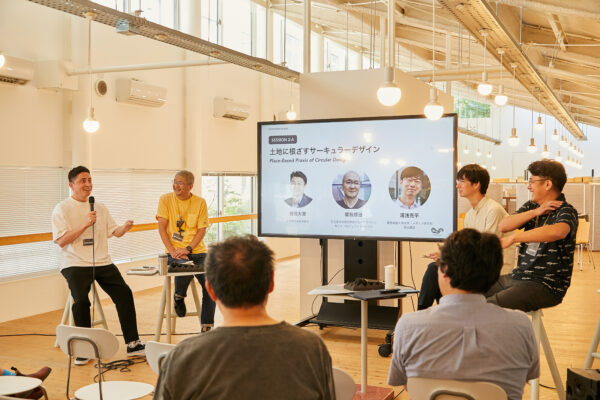
左から増井氏、曽我氏、湯浅特任講師、西塔氏
素材の成分表示と市民の素材への理解度が
ポジティブな変化を生み出す
資源循環をめぐる課題のひとつとしてあるのが、多くの製品がその後の分別や再生を前提につくられていないということ。とりわけ複合素材や破砕処理された素材は素材識別が困難だ。議論では、材質の成分表示の必要性や、メーカーをエンパワメントする市民の声の大切さなどが挙げられた。また、わずかな市民の意識が全体の行動変容を起こすという実践を通した実感も述べられた。
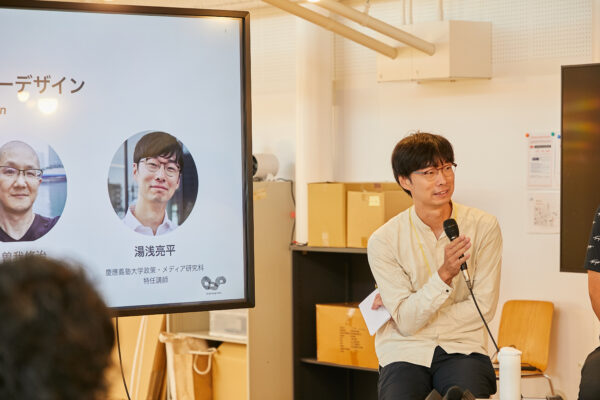
湯浅:ぜひメーカーさんにお願いしたいことは、材料の成分情報を公にすることです。成分表示を見て、「これなら再利用できる」という動機で次のメーカーさんが選ぶといった、ポジティブな変化も生まれるかもしれないと思うんですね。
西塔:大崎町には年間100社近い企業からコラボレーションのオファーがあるのですが、そこでよく「えっ?」と思うのが、商品をつくる工程のなかにパッケージの廃棄まで考えるプロセスがそもそもないことなんです。そのことが購買につながらないから重要視されていない。でも、買う側である市民から「未来のために必要なんです」という声があがれば、変わる企業も出てくるのではないかと。そこからテストケースが生まれて、次に繋がっていくかもしれないというのは、現場ですごく感じることです。
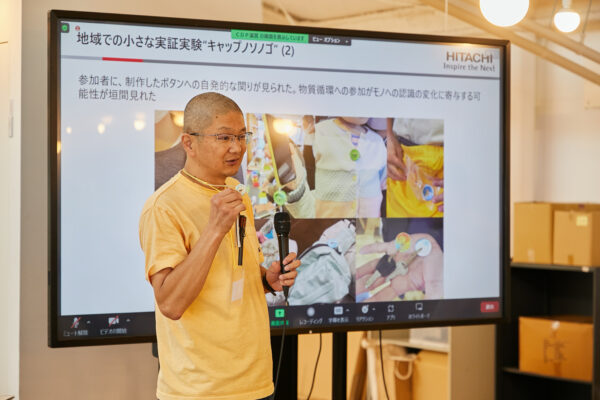
曽我:成分表示をしっかりしていくというのは大事ですし、大崎町のように成分表示をすることの意味や出口が見えると、それは企業側としてもすごく説得力があると思います。あと、江戸時代の循環社会のシステムの調査では、子どものころから稲藁だとか灰だとかに慣れ親しんできたことによって、普通の人たちが素材のことをとても理解していたことがわかりました。いま、市民がプラスチックをどこまで理解することが可能なのかはわからないですけれども、市民が素材の理解にもう一回トライすることと、メーカーがしっかり成分表示することが繋がってきてほしいですね。
西塔:これは大崎町で実感していることなんですけれど、市民の2%ぐらいの人が納得して行動を起こすようになると、物事は動くんですよ。自分たちが仕分けた生ゴミは堆肥になって◯△農園で使われているんだよ、ペットボトルはこういう会社に行ってこういうふうに使われているんだよって説明できる住民の方が2〜3%でもいるだけで、全体で行動変容が起きているし、維持されつづけている。それって、すごく希望だなと思います。
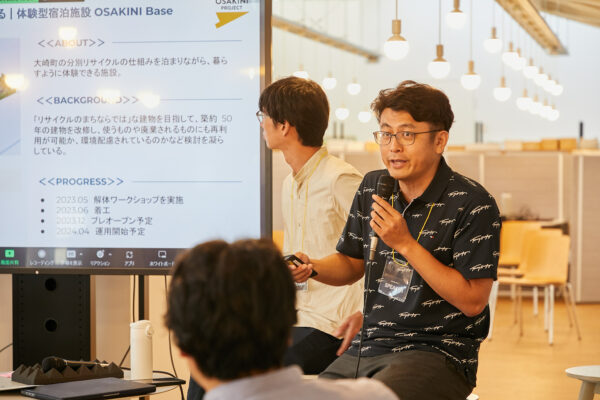
Session B サーキュラーデザインの人材育成
登壇者:
工藤尚悟 [国際教養大学 准教授]
水野大二郎 [京都工芸繊維大学 教授]
ファシリテーター:
市川文子[株式会社Re:Public]
サーキュラーデザインの実践のために
求められる学習環境とは
サーキュラーデザインの実践は、物質が実際に循環する土地の伝統や風土、その土地に生きる利害関係者やその場を取り巻く自然環境といった多様な要素の上に成り立っている。サーキュラーデザインを実践する人材の教育にあたっても、土地ごとの文脈に深く入り込むことを可能にする学習環境への移行が求められているといえる。このセッションでは、新たなデザイン教育のあり方を実践を通して模索している工藤氏と水野氏が、今後のあるべき学習環境について議論。専門性や研究手法に重点を置く一方で認識論を疎かにする日本の高等教育の問題点、学問領域を横断するリベラルアーツ的なデザインの必要性などが語られた。
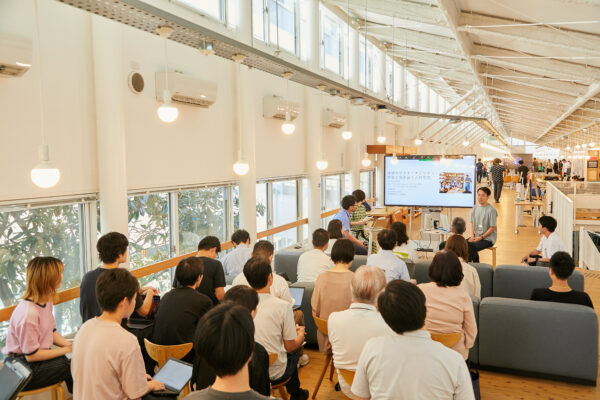
「課題解決型デザイン思考」から抜け出し、
自分のポジショナリティを問う「探索的」なアプローチを
このセッションでは、サーキュラーデザイン人材の教育を考えるにあたり、「課題解決型思考パラダイムからいかに撤退していくか」がメインテーマとなった。デザインする対象の長期化で「課題解決型」では対応に限界が出ているだけではなく、いま社会に残されているのが簡単には解決できない「厄介な問題」ばかりであるという難題を抱えているからだ。高度な人材育成が求められるなか、今後は「課題解決型」とは違う、どのようなアプローチが考えられるのだろうか。
水野:サーキュラーデザイン人材の育成に必要なのは何かを考えるとき、これからはみんなが置いておいてしまった問題に取り組まなくてはいけないという前提がありますよね。その問題の多くは「厄介な問題」で、1+1=2のような正確な答えもなければ、答えを出した瞬間に別の問題が発生するといったような、厄介な性質を帯びていると。そうしたなかで、探索的なやり方──あらゆる可能性を示し、どのようなポジティブ/ネガティブのインパクトを生むのかを話し合い、民主主義的な合意形成に基づいて探索結果を地域や企業、行政組織に挿入するというデザイナリーなやり方があると思うんです。
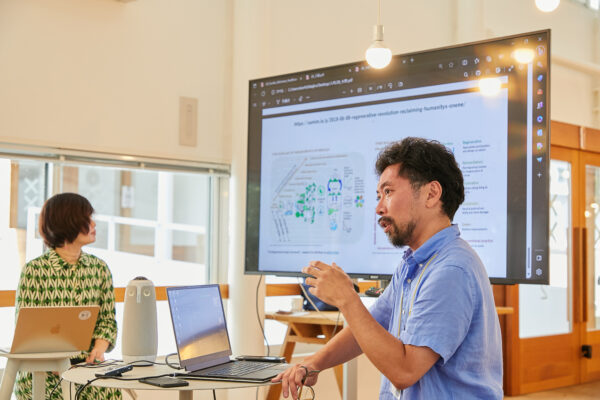
水野: でも、よくわからないけれど、みんなあんまり好きじゃないんですよ。そこには権力関係の問題というのもひとつあるだろうと思うんですが、もうひとつは「先生これで合っていますか」問題。つまり、一発で正確な答えを出して全員を納得させないといけないという謎の風潮があって、「失敗したら死ぬ」と思っている。探索的であるというのはひとつの態度表明だと思うんですけれど、それを阻害する、組織的な何か、あるいは学習して後天的に取得された何かがあるんじゃないかなと。それがちょっと問題としては大きいかなと思いますね。
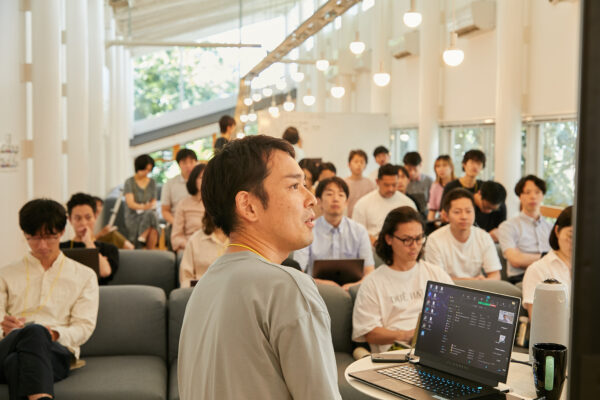
工藤:いまの水野先生のポイントにも繋がるんですけれど、その探索的にやるときの「私はどこにいるのか」ということに、私はすごく興味があるんですね。従来の西洋近代的な科学、いわゆるデカルト的な科学というのは、自分の取り組む対象をいったん自分の外に出すんですよ。そこで客観的に分析し、方法や解決を導く。こうした従来の「課題解決型」の限界を我々は危惧している。
私自身は、秋田県の五城目町という過疎高齢化が進む地域を拠点にして、自分がシステムに入るということをしています。議論しようとしている客体がシステムとしてあって、「研究者としてそこにいる」のではなく「私がここにいる」んですね。ということは、考え方としては、私が変化することで、システムに変化を起こすことが可能になるんです。
なので、学生たちにも自分のポジショナリティを問うようなかかわり方、暮らすようにかかわってほしいと思い、プログラムを構成しています。そして、自分たちの身の回りを良くすることで自分の暮らしが豊かになる、一番の受益者が自分というかたちの変化を連続的に起こしていくと、システムとして全体が変容するのではないか。実際、スケールアップするためのアントレプレナーシップではなく、日々の暮らしを良くするための企てという意味での「ローカル・アントレプレナーシップ」が起きているように感じています。
Session C サーキュラーデザインの制度設計
登壇者:
早渕百合子 [九州大学 准教授]
峯村昇吾 [造形構想株式会社 代表取締役]
ファシリテーター:
田村 大[株式会社Re:Public]
法律・制度の整備が加速するなかで
現状の課題・論点を整理
2022年4月にプラスチック資源循環促進法が施行され、現在は資源有効利用促進法の対象品目に太陽光パネル、蓄電池、衣類・衣服を追加するなどという同法の見直しをはじめとし、サーキュラーエコノミーの実現に向けた法律や制度の整備が進められている。しかし、土地に根ざしたサーキュラーデザインの実践を社会に広く促すためには、制度的な諸課題が山積しているのが現状だ。このセッションでは、現行制度の源流をたどったうえで、個別産業や循環社会を目指す自治体の現場からの視点、システムの可視化・共有の必要性など、サーキュラーデザインの実践を促進するために必要なポイントが数多く挙げられた。
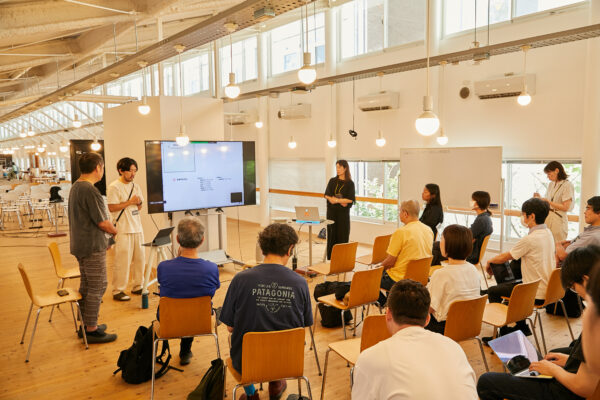
市民の意思決定が、循環社会に向けた
政策推進に大きな影響を与える
日本の京都議定書温室効果ガス排出量算定や国連気候変動枠組条約締約国会議での交渉経験を持つ早渕氏と、アパレル業界におけるサーキュラリティを研究テーマとする峯村氏。議論では、国際的な枠組みが現行の企業の取り組みへと落とし込まれていった経緯を踏まえ、現時点では制度設計に遅れをとっているアパレル産業の現状、さらに政策推進には市民の意思決定が欠かせないことなど、幅広い視点・論点が提示された。
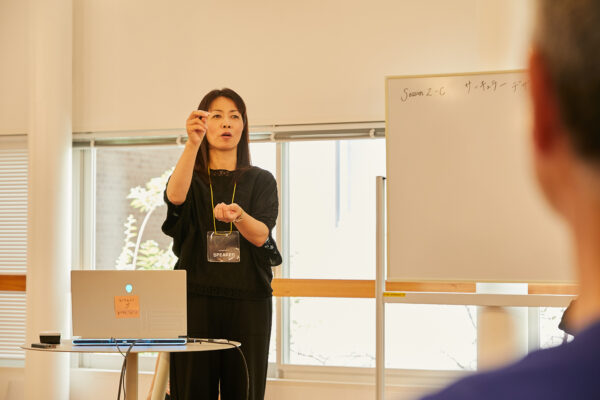
早渕:気づけば、企業はScope3(サプライチェーンにおいて事業者の活動に関連する他社の温室効果ガス排出量)の計算をしなくてはならないとか、自治体もカーボンニュートラル宣言を打ち出すなどしていますが、国際的な大きな流れを押さえておくと、企業がサプライチェーン全体の温室効果ガス排出量を求められるようになった原点は、パリ協定の前文のなかに「Non-Party Stakeholders」、政府ではない企業や自治体、NGO、市民などの役割について言及されたことを受けてのものでした。また、企業がパリ協定の水準に沿った削減目標をつくるSBT(Science Based Targets)の認定など、パリ協定を契機にして、ターゲットを設定し、どういう取り組みが必要なのかを考える流れが生まれました。
一方、私は排出量の計算だけではなく、自治体でプラスチックの組成調査もおこなっているのですが、そうした現場で感じるのは、行政が制度をつくってトップダウンで下ろすのではなく、その前段階として分別と焼却炉使用の差をていねいに説明したりワークショップをおこなったり、住民判断としてどんな将来を選択するのかということを考える機会を設けることの大切さです。それがあることで、政策が実行されたときの参加や貢献にも大きく影響が出ると指摘されています。
峯村:僕はアパレル産業に携わってきましたが、現場レベルでは、政策を気にしたことはほぼありませんでした。そもそも、国内には繊維製品の廃棄やリサイクルにかんする法規制がなく、産業全体として市場における経済性が優先されていて、認証取得にしても「予算が出るからB Corp認証を取りたい」といった動機に基づいているように感じます。
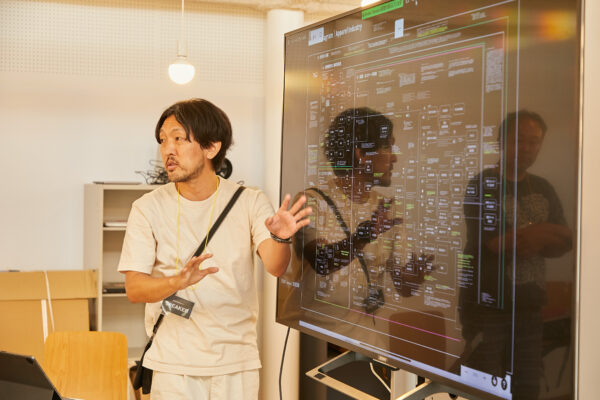
峯村: アパレル産業の問題点の例としてわかりやすいのが、産業間連携によるPETボトルの産業からアパレルの産業への移行です。PETボトルは回収率が96.7%、再資源化率88.5%と非常に高く、そのうちアパレル産業に約30%が流れていると言われていますが、アパレル業界の回収率は32%、サーキュラリティも34%しかありません。PETボトル業界からしてみれば、ほとんど循環しない業界にわざわざ資源を流すことはないと言われると思うのですが、社会課題に取り組むことを営利活動として捉えると、アパレル業界としては再生ポリエステルを採用したいんですよね。このようにふたつの産業を俯瞰してみても、制度やシステムづくりがとても大事だと思います。
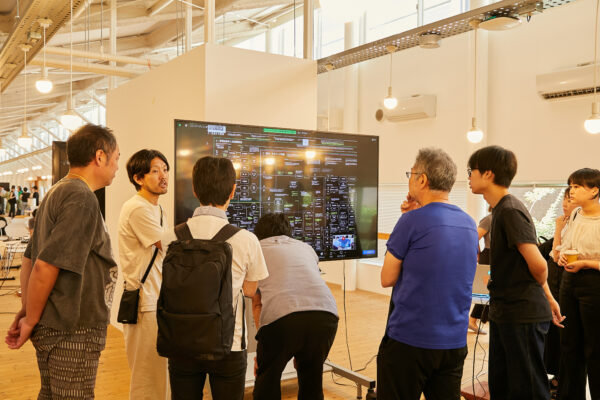
セッション終了後、峯村氏によるアパレル産業のサーキュラーダイアグラムに関心が集まる。他産業とのつながりや時間軸の必要性など、さらなるアップデートを見据えたトークが繰り広げられた。
基調講演
赤間陽子 [Associate Professor, RMIT University]
シンポジウムの締めくくりとしておこなわれた、デザイン研究者であり豪RMIT大学准教授である赤間氏の基調講演。講演では、ドミナントデザインを植民地主義の構造になぞらえたうえで、支配的なドミナントデザインの価値観が身体や土地に根付いていないデザイナーを生んでしまっていると指摘。アンラーニングとして、相互関係を前提とする関係的・非バイナリー的なあり方や多様性の概念を可能にする「アーキペラゴ=群島の考え方」が提示された。
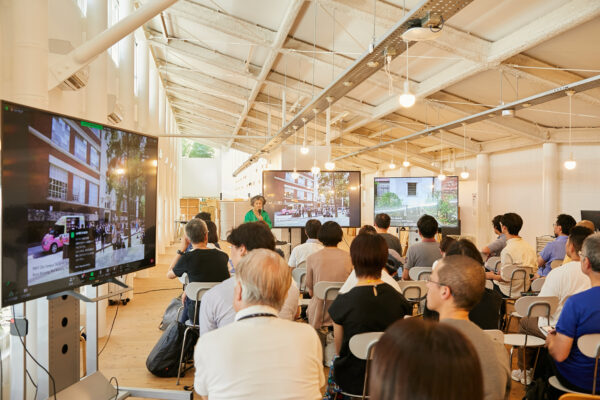
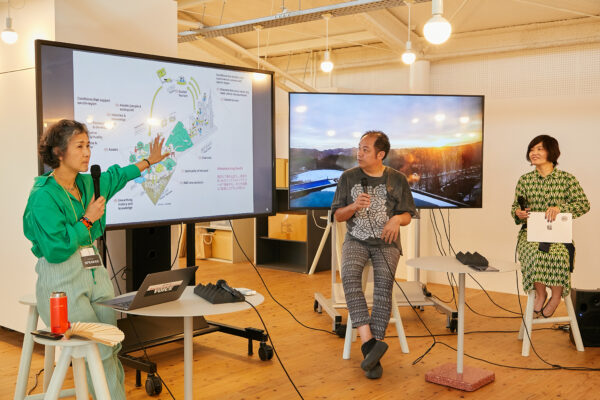
中盤には株式会社Re:Publicの田村氏と市川氏を交え、福岡県八女市の「うなぎの寝床」の取り組みについてトーク。地域産業やそこで生活する人々によるイノベーションの可能性についてインタビューが展開された。
また、サーキュラーの概念は円滑で完璧な循環システムだとみなされているものの実際には汚染や摩擦、不平等などが存在し、同時にわたしたちの体と心が概念図の中に入っていないという問題が挙げられ、サーキュラーに代わって「縁」として捉えてみる視点を提案。そこには偶然の出会いの可能性や、失われた大切なものの不在への気づきがあることが語られた。
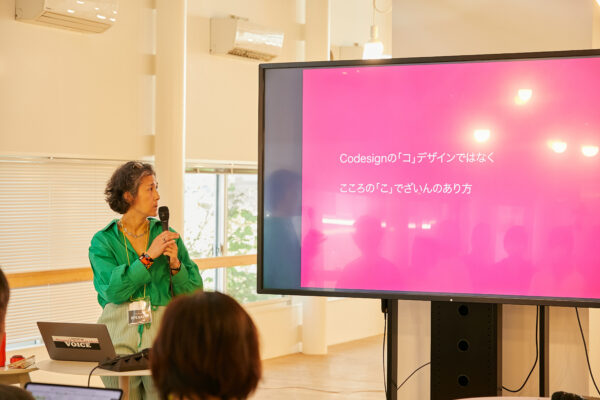
さらに「コ・デザイン」を、「心」の頭文字をとった「こ・デザイン」として捉えたとき、現在の協働的な方法論からより膨らみが生まれるのではないかという可能性についても言及がなされた。
講演の終盤にはアクティビティを実施。参加者がキャンパス内を探索し、人や自然、人工物が互いに作用しあう「多元世界」のきっかけだと感じたものを絵馬に記した。
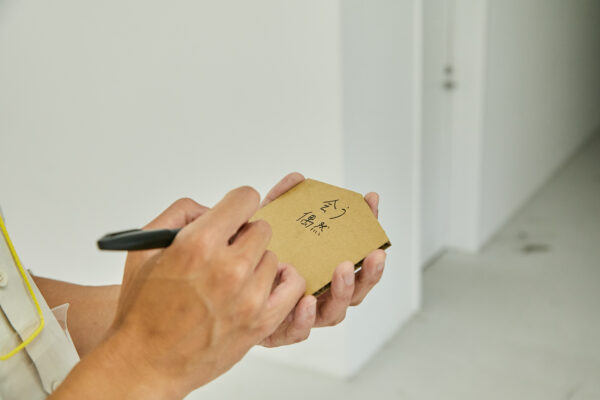
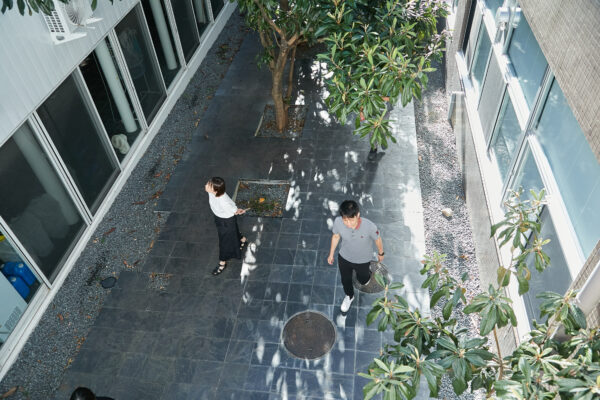
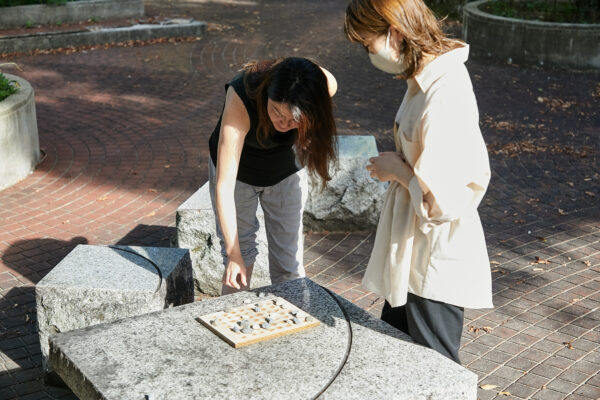
赤間:Circular Design Praxisを、多くの島々、アーキペラゴに向けた出航だと考えてみましょう。群島はつねに複数であり、孤立していません。互いに結びを築き、支配されていた近代の大陸から出発する勇気、サポート、インスピレーションを見つけることができるかもしれません。
しかし、群島に航海するときには出発も旅もそれ自体が困難で、価値観の違い、世界観の違いなどを覚悟しておかなければなりません。群島の間を流れる海の流れは圧倒的で、穏やかな海路はありません。海に入るときには潮の引きやうねり、深さに警戒する必要があるのと同じように、絡み合う状態こそが我々の既存の状態であると認識し、知ること、アクセスすること、理論化できないことに対してつねに注意深く敏感に反応できる状態で、敬意と感受性を持って“違い”にかかわらなければならないと思っています。
これからみなさんと島々へ出航、航海するのを楽しみにしています。ありがとうございました。
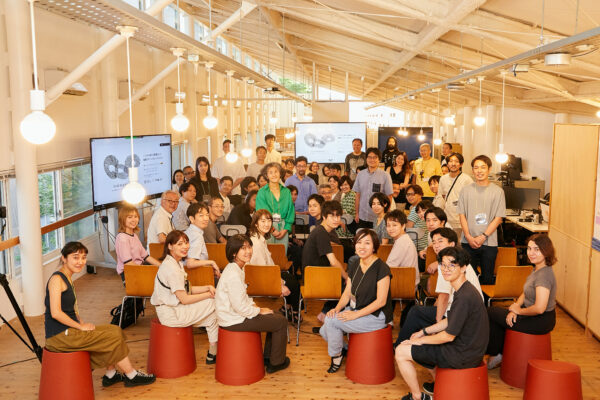
At Kyoto Institute of Technology’s KYOTO Design Lab, we are hosting a series of five consecutive symposiums to commemorate the 10th anniversary of KYOTO Design Lab. Guided by the slogan “Designing Possible Futures,” we delve into discussions about our potential future as an academic hub for the next generation in the fields of urban planning, design, and architecture.
From August 25th to August 27th, 2023, we celebrated the inauguration of this series with the first symposium, titled “Circular Design for System Transition,” held over the course of three days (co-hosted by Circular Design Praxis and Re:Public). We are now delighted to share the crux of these discussions.
The details regarding symposium speakers, schedule, and more can be found here.
DAY 0/2023.8.25
Prior to the symposium, students and faculty members from Kanazawa University, Keio University, and Kyoto Institute of Technology came together for themed discussions and presentations, serving as a prelude to the symposium that would begin the following day.
The students were organized into three groups, each delving into specific themes: “Transitioning from Waste to Resources: When does waste become waste?”, “Reproduction of Overlooked Elements,” and “The Role of Rules in Forging Consensus for a Sustainable Society.” During their respective presentations, they emphasized the significance of conceptualizing circularity as a continuous “cycle” and illuminated the pivotal role of evocative keywords that inspire the transformation of waste into valuable resources. They also discussed the need for updating environmental awareness through design actions and advocated for a bottom-up worldview that should serve as the foundation of a sustainable society. These discussions were further explored and enriched with the participation of researchers.

Student groups were created among students from Kanazawa University, Kyoto Institute of Technology, and Keio University, where they delved into discussions on themes tailored to their individual fields of study.

Symposium speakers also joined each group, sparking enthusiastic discussions that went beyond the boundaries of universities and research disciplines.


The discussions within each group were condensed into newspaper-style summaries, which were then presented in order. Faculty members and symposium speakers provided feedback, inspiring further discussions.
DAY 1/2023.8.26
On the day when the full-fledged symposium commenced, three sessions were held with the themes of “Autonomous, Distributed and Circular Flow,” “Business and Industrial Ecology,” and “Place-Based and Indigenous Practice.”
In Session A, “Autonomous, Distributed and Circular Flow,” discussions began with the evolution of recycling in Japan and covered various aspects of the reality of circular systems from both macro and micro perspectives.
In Session B, “Business and Industrial Ecology,” the current state and future direction of Life Cycle Assessment (LCA), which is currently experiencing significant growth. Opinions were exchanged on how to expand awareness among consumers and businesses.
Lastly, in Session C, “Place-Based and Indigenous Practice,” the discussion revolved around the fundamental issue of inherent violence in a circular society. It explored the transition towards regional-based industries and the effectiveness of non-violence-focused design strategies.

Not only researchers, but a total of 135 attendees from different companies and local governments gathered, along with an additional 123 online viewers. To kick off the event, we allocated some time for ice-breaking discussions on topics of shared interest.
Session A
Autonomous, Distributed and Circular Flow
Speakers:
Hiroya Tanaka [Professor, Keio University]
Tomohiro Tasaki [Material Cycles and Social Systems Research Section, National Institute for Environmental Studies]
Facilitators:
Kazutoshi Tsuda [Associate Professor, Kyoto Institute of Technology]
Fumiko Ichikawa [Re:Public]
From Consumers to Circulators: Conveying the Social Value of Resource Circulation through Narratives
In tackling the challenge of shifting from a society often dubbed “gigaton flooding,” characterized by mass production, mass consumption, and mass disposal, to one centered around balanced production, autonomous decentralized system, and resource circulation, this session featured two experts: Mr. Tasaki, who has extensive experience in researching, analyzing, and evaluating international and national macro environmental policies, and Mr. Tanaka, who specializes in practical and diverse approaches to resource circulation, including the application of digital fabrication in Kamakura City.
Throughout the discussion, the emphasis was placed on recognizing the real-world dynamics and core principles of recycling, encouraging citizens to identify as circulators rather than just consumers, and underscoring the importance of framing the societal value of resource circulation as a compelling narrative to drive these shifts in awareness and behavior.

From left to right: Ms. Ichikawa, Associate Professor Tsuda, Director Tasaki, and Professor Tanaka.
Strategies for Transitioning from Flow Circulation to Stock Circulation
One of the topics that has emerged in the discussion on resource circulation is the issue of whether there is a limit to the amount that can be recycled. While efforts to increase recycling rates are progressing, there is growing concern about whether there will be enough demand to recycle and fully utilize the current stock in a society where population decline is advancing, even 30 years from now. This session also explored the strategies and perspectives necessary for transitioning from the circulation of flows to the circulation of stocks.
Tanaka (on the right in the image): I believe it’s probably a mistake to view things solely through the lens of recycling rates or the word “recycling.” We need to work backward from questions like “Where is this going, and what is the real demand for it?” I don’t think recycling is all that commendable, to be honest.

Tasaki: There is indeed a limit to the amount that can be circulated at some point, so we need to keep that in mind and control it by using resources over the long term. In other words, I believe it’s essential to design with the premise of extended use in mind.
Tanaka: The municipality I’m involved with is still in the middle of its journey, stuck in the phase of mass recycling based on the premise of mass production and mass consumption. The emphasis on “mass” is still preserved in our approach. I believe we need strategies to reduce the emphasis on quantity and shift from flow circulation to stock circulation.
However, there are challenges, such as the difference in materials used in flow circulation and stock circulation. I’m still grappling with how to bridge that gap.
Tasaki: Maybe building from the start with wood and circulating it as biomass, for instance.

Tanaka: I’m involved in research to improve the weather resistance of plastic, but it’s quite a forced effort. Whether it’s a good or bad idea to construct buildings with plastic is a matter of debate. In the midst of this, I have one idea in mind, and that is creating things that float. Anticipating the increasing impact of natural disasters like floods due to global warming, the concept is to design structures that resemble boats, designed to float as much as possible. It’s purely a personal concept I have in mind.
Session B
Business and Industrial Ecology
Speakers:
Satoko Okubayashi [Professor, Kyoto Institute of Technology]
Eri Amasawa [Special Appointed Associate Professor, University of Tokyo]
Ikoho Kochi [Associate Professor, Kanazawa University]
Facilitators:
Daijiro Mizuno [Professor, Kyoto Institute of Technology]
Hiroshi Tamura [Re:Public]
Organizing Key Aspects for Advancing Sustainable Economic and Technological Systems
The concept of circular systems in industries, focusing on the ecosystems of nature, was proposed in the 1990s as a step towards a sustainable society. However, even more than two decades later, the development of sustainable economic and technological systems, including zero-waste production, waste recycling, inverse manufacturing, and the effective utilization of surplus resources like sharing and rentals, remains a work in progress.
In this session, three researchers with diverse backgrounds came together to discuss the various challenges that need to be overcome for the transition to a circular economy. Topics included the current status of Life Cycle Assessment (LCA), the issue of “learned helplessness” experienced by consumers, and the necessity of altering perspectives when evaluating corporate activities.

From right to left: Mr. Tamura, Professor Mizuno, Associate Professor Kochi, Special Appointed Associate Professor Amasawa, and Professor Okubayashi.
Can Prospective LCA Influence Behavioral Change?
In recent years, there has been a growing demand for Prospective LCA. Unlike the conventional LCA that assesses the environmental impact from the production, provision, and disposal of already established products and services, Prospective LCA evaluates the environmental burden of uncertain new technologies and services in their development stages. This prompts a crucial question: Could Prospective LCA become a pivotal tool for instigating behavioral change? This question sparked a lively exchange of perspectives and ideas.

Amasawa: In the center I’m currently affiliated with, we’ve established a new organization called the LCA Center for Future Strategy. The concept behind it is that if we can proactively understand environmental impacts in advance, we can strategically leverage this information in product development and business ventures. We’ve also invited participation from companies, with the goal of collectively shaping the future direction of LCA.
Mizuno: I find it very fascinating. However, it also seems like we might need to discuss to what extent we should engage in a bit of “pie in the sky” thinking. If we’re not careful, we might have to envision an entirely new future, including new industrial ecosystems and new consumer profiles, in order to fully grasp and depict the potential outcomes, don’t you think?
Amasawa: Painting such a comprehensive picture is indeed quite challenging, so we’re approaching it with the assumption that the current world will continue as it is. Additionally, we haven’t fully considered behavioral changes up to this point, so I agree that it’s essential to incorporate that aspect.
Mizuno: Earlier, Professor Kochi mentioned the idea that changing the conscious and unconscious beliefs and values of people underlying the social system might influence behavioral change towards environmental issues. How do you view the relationship between Prospective LCA and consumer behavioral change?

Kochi: I believe it’s extremely important. When consumers are confronted with information that goes beyond their cognition and understanding, they often end up in a situation where they don’t know what’s best. Therefore, I believe it’s crucial to simplify and convey key parameters within the scope of consumer comprehension, such as, “If this changes, this is what will happen.” By presenting this information in a simple and straightforward manner, consumers may be better equipped to initiate behavioral changes based on it.

Mizuno: It’s like recognizing a sense of self-efficacy towards our planet, isn’t it? On this topic, I’d like to hear from Professor Okubayashi since he is presumably on the production side. Professor Okubayashi, your research is on supercritical dyeing with carbon dioxide, which doesn’t use water and addresses issues related to water resource usage during industrial manufacturing. However, there may be aspects where the logic from the production side hasn’t fully considered aligning with the consumer side. What are your thoughts on this?
Okubayashi: In fact, the status of supercritical dyeing is still uncertain in terms of its alignment with LCA principles. Nevertheless, we believe that something like Prospective LCA, a preliminary evaluation, is necessary. We have an ongoing project within our institution dedicated to addressing this issue. Furthermore, while supercritical dyeing is already being practiced in countries like Thailand, Vietnam, and Taiwan, regulatory constraints in Japan have prevented its adoption here. So, it’s currently unlikely that this technology will be a primary factor influencing purchasing decisions in Japan.

Session C
Place-Based and Indigenous Practice
Speakers:
Yutaka Nakamura [Professor, Tama Art University]
Daichi Iwase [Associate Professor, Tokyo Zokei University]
Facilitators:
Tomohide Mizuuchi [Associate Professor, Kyoto Institute of Technology]
Ryota Kamio [Re:Public]
Exploring Regionalistic Production and Non-Violence as Keys to Depart from Imperial Lifestyles
How can we design a society that thrives within the limits and boundaries of environmental capacity through resource recycling? The key to this lies in Regionalistic Production, which leverages local resources, traditional knowledge, and technology. Wisdom deeply ingrained in various regions, passed down from pre-modern times, offers a diverse perspective often overlooked by modernity. During this session, we shared real-life examples of regionalistic production in the Global South as a model to break free from the imperial lifestyle and foster long-term transformation. Additionally, we emphasized the importance of addressing violence, including resource exploitation, and the process of non-violence in the context of circular design.

Uncovering the Violence Embedded in Recycling-Based Societies and Designing Systems to Mitigate It
Japan and Western economies have historically thrived by exploiting resources in developing countries, a form of violence that underpinned their economic growth. Unfortunately, the mass circulation of resources can also contribute to an increase in such exploitation. How can we address the issue of violence in a circular society and provide designs for non-violence? This discussion explored crucial themes, akin to attitudes, essential for progressing towards circular design.

Nakamura: The 20th century witnessed a multitude of designs that, under the guise of problem-solving, actually increased and accelerated violence. As we entered the 21st century, the efficiency of violence further improved. Organized and institutionalized violence, born from the fusion of scientific knowledge, economic capitalism, and the creativity of design, gradually blended into our lives and went unnoticed. It’s essential not only to address direct and overt forms of violence but also to focus on these structural and collective manifestations of violence. Design, I believe, holds the power to address and eliminate such violence.

Iwase: Capitalist society, even in addressing environmental issues, fundamentally exhibits a form of structural violence. We are often shielded from or kept unaware of these violent aspects. Listening to Professor Nakamura’s discussion, I realized the importance of recognizing that circular design and a circular economy can also encompass such inherent violence. Even if we were to achieve a fully circular society, we cannot avoid some level of violence, such as resource exploitation and waste generation. It’s crucial to design a circular society with this understanding in mind.
Nakamura: That’s right. Building a completely non-violent world is not feasible, so preventive, ameliorative, restorative, and healing approaches are crucial. I believe that design can provide systems where violence is further reduced, or systems that are less prone to sudden large-scale violence. We are currently at a stage where we can delve into these possibilities.
For instance, the design of our desires, which has evolved within capitalism, has taken considerable time. However, if we consider that design has exerted a force that rapidly spreads worldwide, we now should aim to redirect that force in the opposite direction. I’m actually quite eager to take on this challenge. Altering mindsets takes a significant amount of time, and when it comes to designing culture, it will likely take at least three generations. However, for urgent issues like climate change, it is necessary to recognize the violence of intervention while designing and implementing solutions. That’s the perspective I’m currently considering.
DAY 2/2023.8.27
On the final day of the symposium, the morning began with a reflection and recap of the previous day’s sessions. Thanks to an idea by Ms.. Yoko Akama, participants had a unique start by experiencing Tai Chi as a clue to “perceiving the worldview through the body.”
The first session, Session A, titled “Place-Based Circular Design,” brought together three practitioners of circular design from different regions and perspectives. They engaged in discussions about the future direction of circular design based on their research results and achievements.
Sessions B and C ran concurrently. In Session B, “Developing Talent for Circular Design,” the keywords revolved around shifting from problem-solving thinking to an exploratory approach. Meanwhile, Session C, “Institutional Design for Circular Design,” brought to light the current challenges faced by industries, local governments, and others from the perspective of legal and institutional development.
To conclude the symposium, Ms. Yoko Akama delivered a keynote speech. His speech proposed various ways to reframe the abstract concept of circulation, incorporating the notions of marginalization and invisibility.
Over the course of three days, the symposium featured a diverse range of themes and speakers. Each theme and issue interlinked organically, providing a multidimensional examination of how design should progress in the future.
Session A Place-Based Circular Design
Speakers:
Motomi Saito [Gassaku Inc., Executive Director]
Shuji Soga [Hitachi, Ltd., Research and Development Group]
Ryohei Yuasa [Keio University, Project Lecturer]
Facilitator:
Takahisa Masui [Re:Public]
Exploring Challenges and Opportunities for Reconstructing Regional Ecology Based on the Circular Society of the Edo Period
To practice place-based circular design, it’s necessary to reconstruct the ecology of that specific place. In this session, Mr. Soga, who investigated the Edo-period circular society still prevalent in Nagahama City, Shiga Prefecture, Mr. Yuasa, who primarily focuses on plastic resource circulation in Kamakura City, Kanagawa Prefecture, and Mr. Saito, who is involved in system development in Osaki Town, Kagoshima Prefecture, known for having Japan’s highest recycling rate, discussed the challenges and possibilities of reconstruction. Various key concepts were presented, such as the importance of raising citizens’ awareness of materials and resources, the collaborative efforts between stakeholders and citizens to create new products and services, and design approaches that foster “attachment” to prevent the disposal of items.

From left to right: Mr. Masui, Mr. Soga, Project Lecturer Yuasa, and Mr. Saito
Fostering Positive Change through Material Composition Labeling and Public Awareness
One of the challenges surrounding resource recycling is that many products are not designed with the assumption of subsequent sorting and recycling. This is particularly problematic for composite materials and materials that have undergone crushing processes, making material identification difficult. The discussion highlighted the importance of material composition labeling and the significance of empowering manufacturers based on feedback from citizens. Additionally, it was noted that the awareness of even a few citizens can lead to a collective behavioral change, as demonstrated through practical experiences.

Yuasa: One thing I would like to request from manufacturers is to make material composition information publicly available. By providing ingredient labels, it might motivate the next manufacturer to choose materials that can be reused, potentially leading to positive changes.
Saito: In Osaki Town, we receive collaboration offers from nearly 100 companies annually, but what often surprises me is that many of them lack a process to consider the disposal of packaging within the product manufacturing process. This is because it’s not seen as important since it doesn’t directly lead to sales. However, if citizens on the buying side start voicing the importance of this for the future, it might encourage companies to change. From there, test cases could emerge and lead to broader transformations. This is something I strongly sense at the grassroots level.

Soga: It’s crucial to have proper ingredient labeling, and when companies can see the significance and potential outcomes of ingredient labeling, as seen in Osaki Town, it can be very convincing for them. Additionally, our research on the circular society system in the Edo period revealed that ordinary people had a deep understanding of materials because they were familiar with things like rice straw and ash from a young age. It’s uncertain how much understanding citizens can have about materials today, especially with regards to plastics, but I hope there can be a connection between citizens giving another try to understand materials and manufacturers providing clear ingredient labeling.
Saito: This is something we’ve experienced in Osaki Town, but when about 2% of the citizens start taking action, things start moving. If even 2-3% of the residents can explain that the organic waste they sorted becomes compost used in a certain farm or that PET bottles are processed in a specific way at a particular company, it leads to a behavioral change across the entire community, and it continues to be sustained. That, to me, is a great source of hope.

Session B Developing Talent for Circular Design
Speakers:
Shogo Kudo [Associate Professor, Akita International University]
Daijiro Mizuno [Professor, Kyoto Institute of Technology]
Facilitator:
Fumiko Ichikawa [Re:Public]
Creating Learning Environments for Circular Design Practice
Circular design practice is built upon a diverse range of elements such as the traditions, local context, stakeholders, and the natural environment of the land where materials are actually circulated. When it comes to educating individuals in circular design, there is a need to transition towards learning environments that enable a deep understanding of the context specific to each location. In this session, Professor Kudo and Professor Mizuno, who are actively exploring new approaches to design education through practical experience, discussed the necessary learning environments for the future. They addressed issues within Japan’s higher education system, which tends to emphasize specialization and research methodologies at the expense of epistemology, and emphasized the necessity of a liberal arts-oriented design approach that transcends disciplinary boundaries.

「Transitioning from Problem-Solving Design Thinking to an Exploratory Approach Questioning Designers’ Positionality
In this session, the main focus was on reimagining the education of circular design professionals by moving away from the problem-solving thinking paradigm. The discussion emphasized that problem-solving approaches not only have limitations when dealing with the design subjects requiring long-term commitment but also because the prevailing issues in society are becoming increasingly complex and challenging to solve. Given the need for advanced talent development, the question arises: What alternative approaches can be considered in contrast to problem-solving thinking?
Mizuno: When thinking about what is needed for the development of circular design talents, there is a premise that we should tackle problems that everyone has left behind. Many of these problems are wicked in nature and don’t have precise answers like 1+1=2. They often generate new issues the moment you find an answer. Within this context, there’s an exploratory approach, which involves exploring all possibilities, discussing the positive and negative impacts they might have, and inserting the results of exploration into communities, businesses, and government organizations based on democratic consensus. I believe this designerly approach is valuable.

Mizuno: However, for some reason, not many people seem to like it. There may be issues related to power dynamics, but another issue is the attitude of asking, “Is this correct, teacher?” In other words, there is a strange atmosphere where you need to provide an accurate answer that satisfies everyone immediately, and there is a fear of “failure equals death.” Being exploratory is a kind of attitude in itself, but there might be something organizational or acquired through learning that inhibits it. I think this could be a somewhat significant issue.

Kudo: What Professor Mizuno pointed out earlier is related to what I’m interested in when approaching exploratory methods. It’s the question of “Where am I in this process?” In traditional Western modern science, often referred to as Cartesian science, you first externalize the subject you’re dealing with. Then, you objectively analyze it and derive methods or solutions. We are concerned about the limitations of this traditional problem-solving approach.
Personally, I am based in a depopulated and aging region called Gojome in Akita Prefecture and approach the local issues by immersing myself within the system. Rather than being there as a researcher who sees the object of discussion as a system, I am there as myself. This means that, by changing myself, I can bring about change within the system.
So, I have structured my programs to encourage students to engage in ways that question their own positionality and to get involved as if they were living there. I believe that by continuously changing themselves, becoming the primary beneficiaries of improving their surroundings, the entire system will transform. In fact, I sense that we are witnessing a form of local entrepreneurship, not for scaling up, but for striving to enhance our own daily lives.
Session C
Institutional Design for Circular Design
Speakers
Yuriko Hayabuchi [Associate Professor, Kyushu University]
Shogo Minemura [Founder and CEO, Zoukei Kousou]
Facilitator
Hiroshi Tamura [Re:Public]
Organizing Current Challenges and Issues Amid Advancements in Legal and Regulatory Frameworks
In April 2022, the Plastic Resource Circulation Promotion Law was enacted, and since then, there have been revisions to this law, such as adding solar panels, storage batteries, clothing, and apparel to the items covered by the Resource Efficient Utilization Promotion Law. These efforts are part of the ongoing process to establish legal and regulatory frameworks for the realization of a circular economy. However, there are still numerous institutional challenges that need to be addressed to promote place-based circular design practices in society. This session delved into the current legal and regulatory landscape, examined the perspectives from local governments and industries striving for a circular society, and emphasized the importance of visualizing and sharing systems, highlighting various key points to facilitate the practice of circular design.

The Impact of Civic Decision-Making on Advancing Circular Economy Policies
Ms. Hayabuchi brings a wealth of experience, having been involved in calculating Japan’s greenhouse gas emissions for the Kyoto Protocol and participating in negotiations at United Nations Climate Change conferences. On the other hand, Mr. Minemura’s expertise lies in researching circularity within the apparel industry. During their discussion, a wide range of perspectives and issues were raised, including considerations of how international frameworks have been incorporated into current corporate initiatives, the current state of regulatory design within the apparel industry, and the crucial role of civic decision-making in driving policy initiatives.

Hayabuchi: Before we knew it, companies are required to calculate Scope 3 emissions (greenhouse gas emissions associated with the activities of companies in their supply chains), and local governments are making carbon-neutral declarations. However, it’s important to understand that the origin of the requirement for companies to assess greenhouse gas emissions across their supply chains can be traced back to the Paris Agreement’s preamble, which mentioned the role of “Non-Party Stakeholders” – not just governments but also businesses, local governments, NGOs, and citizens. Additionally, the Paris Agreement has led to the creation of initiatives such as Science Based Targets (SBT), where companies set reduction targets in line with the Paris Agreement’s standards and consider what actions are necessary.
On the other hand, in addition to calculating emissions, I have been conducting compositional surveys of plastics in local governments. What I have noticed in these practical scenarios is the importance of not just creating top-down policies but also providing opportunities like workshops for local residents to learn the difference between sorting and incineration, and discussing what future choices residents want to make before the government implements any regulations. It has been pointed out that having such opportunities greatly influences residents’ participation and contributions when policies are implemented.
Minemura: I’ve been involved in the apparel industry, but at the grassroots level, we rarely paid attention to policies. Firstly, there are no regulations in Japan regarding the disposal and recycling of textile products. Moreover, the industry as a whole prioritizes economic viability in the market. It seems that the pursuit of certifications, such as the B Corp certification, is often driven by the anticipation of securing budget allocations.

Minemura: One illustrative example of the challenges in the apparel industry is the transition from the plastic bottle industry to the apparel industry through inter-industry collaboration. Plastic bottles boast an impressive collection rate of 96.7% and a recycling rate of 88.5%, with approximately 30% of them reportedly finding their way into the apparel industry. However, the apparel industry lags behind with a collection rate of only 32% and a circularity rate of merely 34%. From the perspective of the plastic bottle industry, it may seem unnecessary to channel resources into an industry that recycles so little. Nevertheless, when tackling societal issues is seen as a profitable endeavor, the apparel industry seeks to incorporate recycled polyester. This underlines the significance of establishing regulatory frameworks and systems, even when examining these two industries from a broader perspective.

After the sessions concluded, attention turned towards Mr. Minemura’s circular diagram for the apparel industry. This sparked discussions about collaboration with other industries and the necessity of a time-based perspective, all with the aim of envisioning further updates within the industry.
Keynote Speech
Yoko Akama [Associate Professor, RMIT University]
The symposium concluded with a keynote speech by Yoko Akama, a design researcher and Associate Professor at RMIT University in Australia. In her speech, she drew parallels between Dominant Design and colonialist structures, highlighting how the values of Dominant Design have resulted in designers who are disconnected from their body and land. She pointed out the importance of unlearning, introducing relational and non-binary approaches that are founded on mutual relationships as well as the concept of Archipelagic Thinking that fosters a deeper understanding of diversity.


During the keynote speech, Mr. Tamura and Ms. Ichikawa from Re:Public were invited to discuss the “Unagi-no-Nedoko” (Eel’s Nest) project in Yame City, Fukuoka Prefecture. Interviews explored the potential for innovation driven by local industries and residents.
Furthermore, while the concept of circularity is often seen as a seamless and flawless system, it was pointed out that in reality, issues such as pollution, friction, and inequality exist. Simultaneously, there is the concern that our bodies and minds are not included within the conceptual framework. To address this, the perspective of considering these elements as “en” (fate, relation) was proposed. This perspective recognizes the potential for serendipitous encounters and brings attention to the absence of precious elements that have been lost.

Moreover, it was noted that a broader perspective beyond current collaborative methodologies could emerge when “Co-design” is conceptualized as “Ko-design,” derived from the initial character for “kokoro” (meaning heart or mind in Japanese).
In the final part of the keynote speech, an engaging activity took place in which participants roamed the campus and inscribed their thoughts on ema (small wooden plaques) about what they perceived as catalysts for the “pluriverse ,” where people, nature, and artifacts interact harmoniously.



Akama: Let’s think of Circular Design Praxis as embarking on a journey towards numerous islands, an archipelago if you will. Archipelagos are always plural and never isolated. They are connected, and perhaps we can find the courage, support, and inspiration to depart from the modern continents that once dominated us.
However, setting sail towards archipelagos is a challenging endeavor in itself. We must be prepared for differences in values, perspectives, and worldviews. The currents flowing between the islands are formidable, and there are no calm passages. Just as we need to be cautious of tides, swells, and depths when entering the sea, we should recognize that this entangled state is our existing condition. When it comes to what we learn, what we access, and what cannot be theorized, we must always maintain a state of being able to respond with care and sensitivity. We must approach “differences” with respect.
I look forward to embarking on this voyage to the islands with all of you in the future. Thank you very much.
